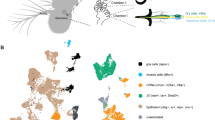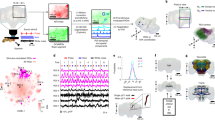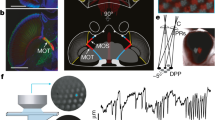Abstract
The neural substrates that the fruitfly Drosophila uses to sense smell, taste and light share marked structural and functional similarities with ours, providing attractive models to dissect sensory stimulus processing. Here we focus on two of the remaining and less understood prime sensory modalities: graviception and hearing. We show that the fly has implemented both sensory modalities into a single system, Johnston’s organ, which houses specialized clusters of mechanosensory neurons, each of which monitors specific movements of the antenna. Gravity- and sound-sensitive neurons differ in their response characteristics, and only the latter express the candidate mechanotransducer channel NompC. The two neural subsets also differ in their central projections, feeding into neural pathways that are reminiscent of the vestibular and auditory pathways in our brain. By establishing the Drosophila counterparts of these sensory systems, our findings provide the basis for a systematic functional and molecular dissection of how different mechanosensory stimuli are detected and processed.
This is a preview of subscription content, access via your institution
Access options
Subscribe to this journal
Receive 51 print issues and online access
$199.00 per year
only $3.90 per issue
Buy this article
- Purchase on Springer Link
- Instant access to full article PDF
Prices may be subject to local taxes which are calculated during checkout






Similar content being viewed by others
References
Toma, D. P., White, K. P., Hirsch, J. & Greenspan, R. J. Identification of genes involved in Drosophila melanogaster geotaxis, a complex behavioral trait. Nature Genet. 31, 349–353 (2002)
Beckingham, K. M., Texada, M. J., Baker, D. A., Munjaal, R. & Armstrong, J. D. Genetics of graviperception in animals. Adv. Genet. 55, 105–145 (2005)
Tempel, B. L., Livingstone, M. S. & Quinn, W. G. Mutations in the dopa decarboxylase gene affect learning in Drosophila. Proc. Natl Acad. Sci. USA 81, 3577–3581 (1984)
Eberl, D. F., Duyk, G. M. & Perrimon, N. A genetic screen for mutations that disrupt an auditory response in Drosophila melanogaster. Proc. Natl Acad. Sci. USA 94, 14837–14842 (1997)
Tauber, E. & Eberl, D. F. Acoustic communication in Drosophila. Behav. Processes 64, 197–210 (2003)
Hudspeth, A. J. in Principles of Neural Science (eds Kandel, E. R., Schwartz, J. H. & Thomas, M. J.) 590–613 (McGraw-Hill, 2000)
Goldberg, M. E. & Hudspeth, A. J. in Principles of Neural Science (eds Kandel, E. R., Schwartz, J. H. & Thomas, M. J.) 801–815 (McGraw-Hill, 2000)
Todi, S. V., Sharma, Y. & Eberl, D. F. Anatomical and molecular design of the Drosophila antenna as a flagellar auditory organ. Microsc. Res. Tech. 63, 388–389 (2004)
Kim, J. et al. A TRPV family ion channel required for hearing in Drosophila. Nature 424, 81–84 (2003)
Caldwell, J. C. & Eberl, D. F. Towards a molecular understanding of Drosophila hearing. J. Neurobiol. 53, 172–189 (2002)
Kernan, M. J. Mechanotransduction and auditory transduction in Drosophila. Pflugers Arch. 454, 703–720 (2007)
Göpfert, M. C. & Robert, D. The mechanical basis of Drosophila audition. J. Exp. Biol. 205, 1199–1208 (2002)
Kamikouchi, A., Shimada, T. & Ito, K. Comprehensive classification of the auditory sensory projections in the brain of the fruit fly Drosophila melanogaster. J. Comp. Neurol. 499, 317–356 (2006)
Göpfert, M. C. & Robert, D. Biomechanics. Turning the key on Drosophila audition. Nature 411, 908 (2001)
Baker, D. A., Beckingham, K. M. & Armstrong, J. D. Functional dissection of the neural substrates for gravitaxic maze behavior in Drosophila melanogaster. J. Comp. Neurol. 501, 756–764 (2007)
Dickson, B. J. Wired for sex: the neurobiology of Drosophila mating decisions. Science 322, 904–909 (2008)
Albert, J. T., Nadrowski, B. & Göpfert, M. C. Mechanical signatures of transducer gating in the Drosophila ear. Curr. Biol. 17, 1000–1006 (2007)
Albert, J. T., Nadrowski, B., Kamikouchi, A. & Göpfert, M. C. Mechanical tracing of protein function in the Drosophila ear. Nature Protocols 10.1038/nprot.2006.364 (2006)
Nadrowski, B., Albert, J. T. & Gopfert, M. C. Transducer-based force generation explains active process in Drosophila hearing. Curr. Biol. 18, 1365–1372 (2008)
Brand, A. H. & Perrimon, N. Targeted gene expression as a means of altering cell fates and generating dominant phenotypes. Development 118, 401–415 (1993)
Miyawaki, A., Griesbeck, O., Heim, R. & Tsien, R. Y. Dynamic and quantitative Ca2+ measurements using improved cameleons. Proc. Natl Acad. Sci. USA 96, 2135–2140 (1999)
Fiala, A. & Spall, T. In vivo calcium imaging of brain activity in Drosophila by transgenic cameleon expression. Sci. STKE 2003, pl6 (2003)
Göpfert, M. C., Albert, J. T., Nadrowski, B. & Kamikouchi, A. Specification of auditory sensitivity by Drosophila TRP channels. Nature Neurosci. 9, 999–1000 (2006)
Sharma, Y., Cheung, U., Larsen, E. W. & Eberl, D. F. PPTGAL, a convenient Gal4 P-element vector for testing expression of enhancer fragments in Drosophila. Genesis 34, 115–118 (2002)
Benzer, S. Behavioral mutants of Drosophila isolated by countercurrent distribution. Proc. Natl Acad. Sci. USA 58, 1112–1119 (1967)
Horn, E. & Lang, H.-G. Positional head reflexes and the role of the prosternal organ in the walking fly, Calliphora erythrocephala. J. Comp. Physiol. [A] 126, 137–146 (1978)
Sweeney, S. T., Broadie, K., Keane, J., Niemann, H. & O’Kane, C. J. Targeted expression of tetanus toxin light chain in Drosophila specifically eliminates synaptic transmission and causes behavioral defects. Neuron 14, 341–351 (1995)
McGuire, S. E., Le, P. T., Osborn, A. J., Matsumoto, K. & Davis, R. L. Spatiotemporal rescue of memory dysfunction in Drosophila. Science 302, 1765–1768 (2003)
Thum, A. S. et al. Differential potencies of effector genes in adult Drosophila. J. Comp. Neurol. 498, 194–203 (2006)
Smith, H. K. et al. Inducible ternary control of transgene expression and cell ablation in Drosophila. Dev. Genes Evol. 206, 14–24 (1996)
Newsome, T. P., Asling, B. & Dickson, B. J. Analysis of Drosophila photoreceptor axon guidance in eye-specific mosaics. Development 127, 851–860 (2000)
Walker, R. G., Willingham, A. T. & Zuker, C. S. A Drosophila mechanosensory transduction channel. Science 287, 2229–2234 (2000)
Liu, L. et al. Drosophila hygrosensation requires the TRP channels water witch and nanchung. Nature 450, 294–298 (2007)
Eberl, D. F., Hardy, R. W. & Kernan, M. J. Genetically similar transduction mechanisms for touch and hearing in Drosophila. J. Neurosci. 20, 5981–5988 (2000)
Otsuna, H. & Ito, K. Systematic analysis of the visual projection neurons of Drosophila melanogaster. I. Lobula-specific pathways. J. Comp. Neurol. 497, 928–958 (2006)
Bacon, J. P. & Strausfeld, N. J. The dipteran ‘Giant fibre’ pathway: neurons and signals. J. Comp. Physiol. [A] 158, 529–548 (1986)
Phelan, P. et al. Mutations in shaking-B prevent electrical synapse formation in the Drosophila giant fiber system. J. Neurosci. 16, 1101–1113 (1996)
Cant, N. B. & Benson, C. G. Parallel auditory pathways: projection patterns of the different neuronal populations in the dorsal and ventral cochlear nuclei. Brain Res. Bull. 60, 457–474 (2003)
Barmack, N. H. Central vestibular system: vestibular nuclei and posterior cerebellum. Brain Res. Bull. 60, 511–541 (2003)
Büttner-Ennever, J. A. A review of otolith pathways to brainstem and cerebellum. Ann. NY Acad. Sci. 871, 51–64 (1999)
Yorozu, S. et al. Distinct sensory representations of wind and near-field sound in the Drosophila brain. Nature 10.1038/nature07843 (this issue)
Ricci, A. J., Kennedy, H. J., Crawford, A. C. & Fettiplace, R. The transduction channel filter in auditory hair cells. J. Neurosci. 25, 7831–7839 (2005)
Wong, A. M., Wang, J. W. & Axel, R. Spatial representation of the glomerular map in the Drosophila protocerebrum. Cell 109, 229–241 (2002)
Keppel, G. & Wickens, T. D. Design and Analysis: A Researcher’s Handbook 4th edn (Prentice Hall, 2004)
Acknowledgements
We thank D. F. Eberl for JO15, C. J. O’Kane for UFWTRA19, B. J. Dickson for UAS-GFP S65T and eyFLP fly strains, H. Tanimoto for flies carrying tubulin-GAL80ts and UAS-tetanus toxin, C. Kim for nandy5, M. J. Kernan for nan36a, L. Liu for nompC-GAL4.25, A. Wong and G. Struhl for UAS > CD2, y > CD8::GFP, J. Urban and G. Technau for MZ-series enhancer trap strains, the members of the NP consortium (a group of eight laboratories in Japan that together produced a large collection of GAL4 lines) and D. Yamamoto for the NP-series strains, Bloomington Stock Centre for elavc155-GAL4, D. F. Eberl and C. P. Kyriacou for courtship sound data, S. Fujita for 22C10 antibody, the Developmental Studies Hybridoma Bank for antibodies anti-Elav and nc82, T. Völler for help with calcium imaging, H. Otsuna and K. Shinomiya for preparing some figures, M. Dübbert, K. Öchsner, M. Matsukuma, S. Shuto and K. Yamashita for technical assistance, J. T. Albert, E. D. Hoopfer, B. Nadrowski, K. Endo, H. Otsuna, Y. Hiromi, E. Buchner and N. J. Strausfeld for discussion, and D. J. Anderson and S. Yorozu for sharing unpublished data. This work was supported by the Japanese Cell Science Research Foundation, the Alexander von Humboldt Foundation, and the Japan Society for the Promotion of Science (to A.K.), the DFG Collaborative Research Centre 554 (to A.F.), the Volkswagen Foundation, the BMBF Bernstein Network for Computational Neuroscience, and the DFG Research Centre Molecular Physiology of the Brain (to M.C.G.), and the Human Frontier Science Program Organisation, BIRD/Japan Science and Technology Agency, and the Japan Society for the Promotion of Science (to K.I.).
Author Contributions A.K., M.C.G. and K.I. designed research; A.K. and A.F. performed calcium imaging. A.K. and H.K.I. performed fly genetics; H.K.I. performed behavioural and anatomical experiments; T.E. performed nerve recordings; A.K., H.K.I. and O.H. performed histology; A.K., H.K.I., M.C.G. and K.I. wrote the paper; and M.C.G. and K.I. supervised the work. All authors discussed the concepts and results, and commented on the manuscript.
Author information
Authors and Affiliations
Corresponding authors
Supplementary information
Supplementary Information
This file contains Supplementary Footnotes S1-S10, Supplementary Figures S1-S7 with Legends, Supplementary Table S1, Supplementary Methods and Supplementary References (PDF 3463 kb)
Supplementary Movie 1
This movie shows the spatial activation of the JO somata array (see file s1 for full legend). (MOV 1354 kb)
Supplementary Movie 2
This movie shows the 3D structure of the zones in the AMMC (see file s1 for full legend). (MOV 4859 kb)
Supplementary Movie 3
This movie shows the serial section of AMMC from the anterior to posterior (see file s1 for full legend). (MOV 9141 kb)
Supplementary Movie 4
This movie shows the counter-current apparatus in action (see file s1 for full legend). (MOV 4315 kb)
Supplementary Movie 5
This movie shows the response of the flies to a synthesized courtship pulse song (see file s1 for full legend). (MOV 8041 kb)
Rights and permissions
About this article
Cite this article
Kamikouchi, A., Inagaki, H., Effertz, T. et al. The neural basis of Drosophila gravity-sensing and hearing. Nature 458, 165–171 (2009). https://doi.org/10.1038/nature07810
Received:
Accepted:
Issue Date:
DOI: https://doi.org/10.1038/nature07810
This article is cited by
-
Why flying insects gather at artificial light
Nature Communications (2024)
-
Evolutionary conservation and diversification of auditory neural circuits that process courtship songs in Drosophila
Scientific Reports (2023)
-
3D escape: an alternative paradigm for spatial orientation studies in insects
Journal of Comparative Physiology A (2023)
-
The role of learning-walk related multisensory experience in rewiring visual circuits in the desert ant brain
Journal of Comparative Physiology A (2023)
-
Olfactory navigation in arthropods
Journal of Comparative Physiology A (2023)
Comments
By submitting a comment you agree to abide by our Terms and Community Guidelines. If you find something abusive or that does not comply with our terms or guidelines please flag it as inappropriate.



